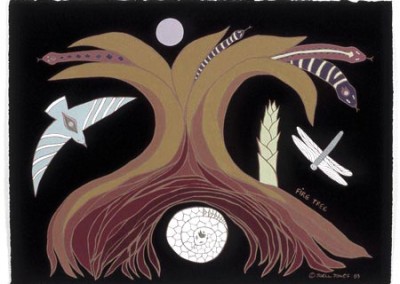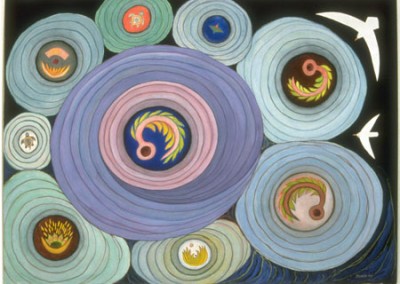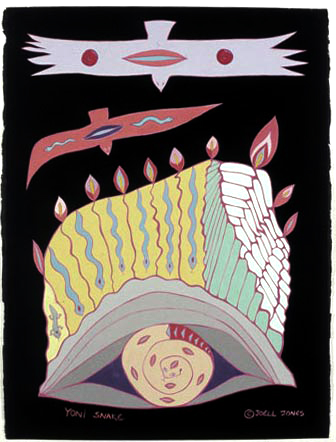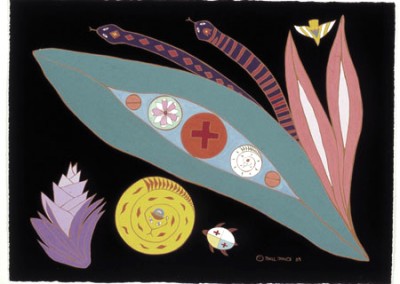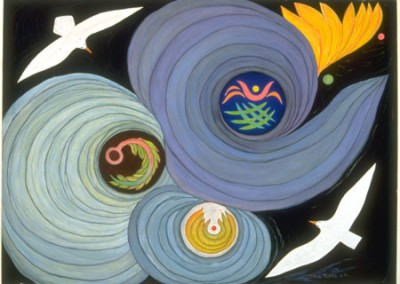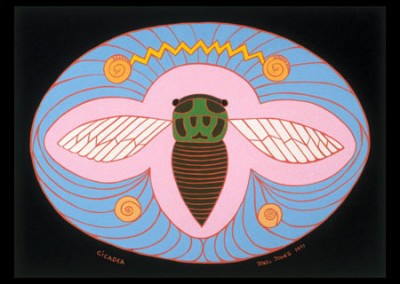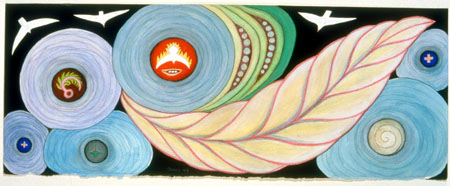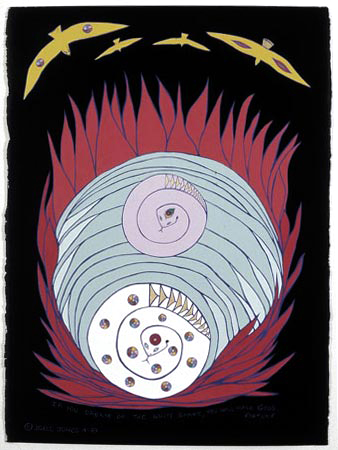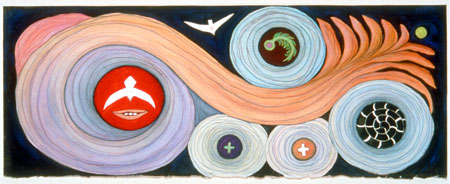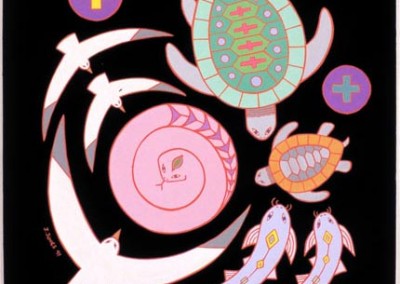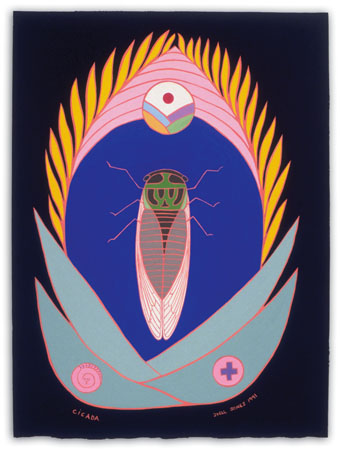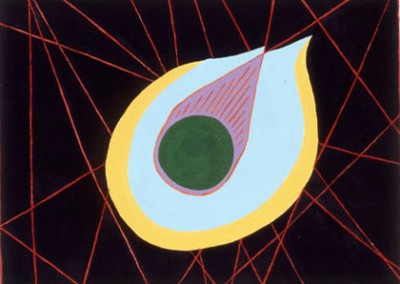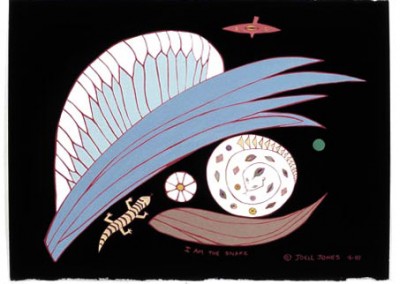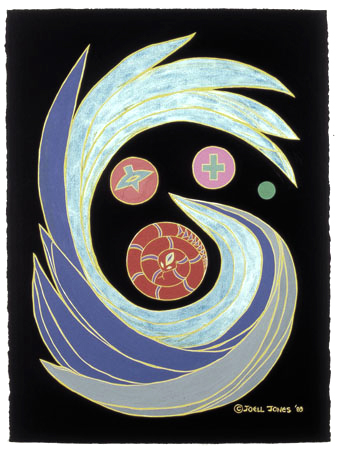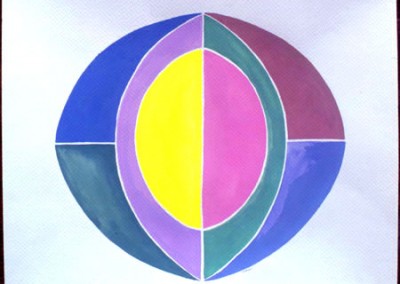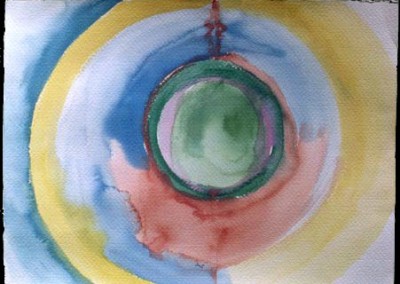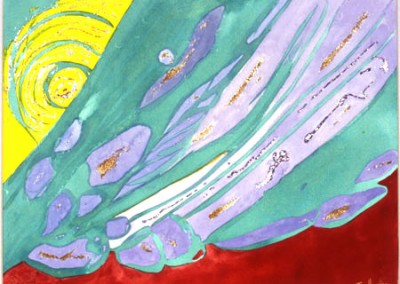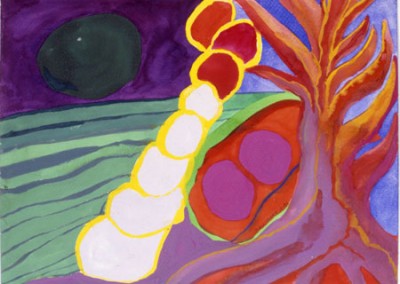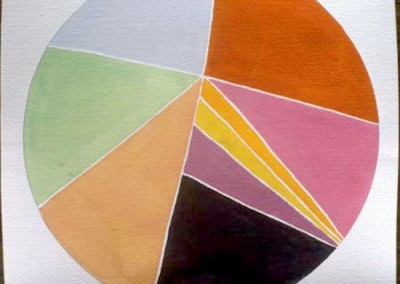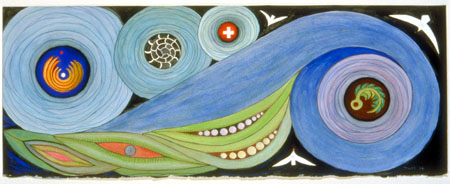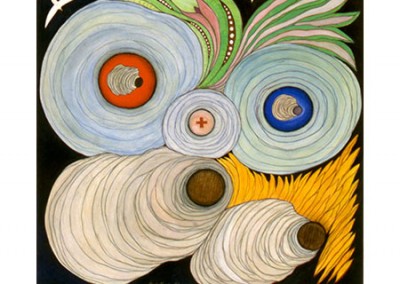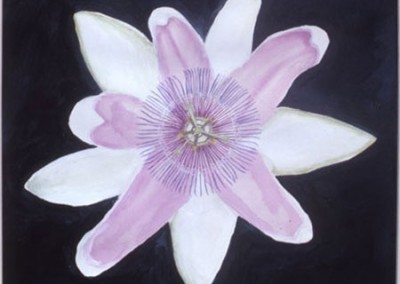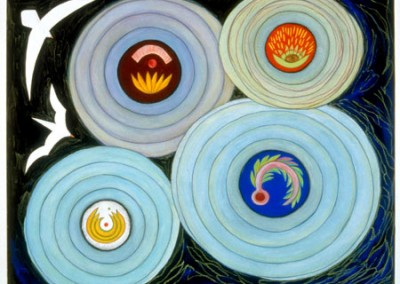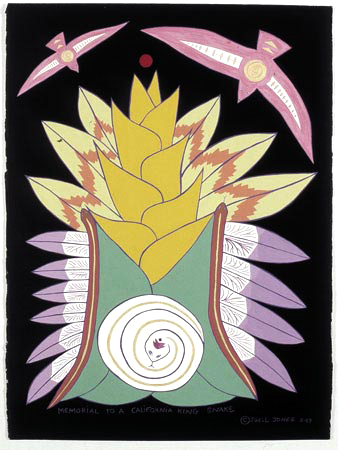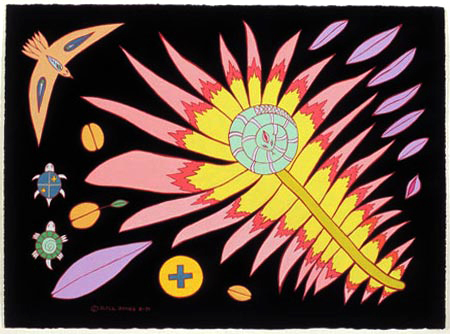
Interview
LOOK. LOOK AGAIN: A critique and analysis of the painter Joell Jones
© Copyright Robyn E. Grant.
1991
Joell Jones is a painter. Perhaps you’ve never seen her works before, its tonal shapes, its verbal colors, its primordial images, the geometries of space now coming forward, now receding into the black, the darkness, the infinite, the chaotic.
You look away. You look again. Yes, here again, there is light against darkness, order is somehow arranged from the omnipresent chaos, there are allegories present, stories to be told, images to be argued, understood, misunderstood. It’s a child’s game. a bedtime story. It’s an adult’s world, a daytime’s dream.
You look away. You look again. The colors before you are working their spells. Emotions and moods come over you. Shapes work their hidden psychologies upon you. You think of Jung, of archetypal images. You sense your own vulnerability to their juxtapositions, for form is the result of such arrangements, and form provides a focus. With this focus you’ve come full circle and are once again in contemplation of light against the darkness, order from chaos, reason from unreason.
The sphere is a snake, no it’s a serpent, no, it’s the moon. The moon is a guide, it governs the tides. At once you’ve begun another story. Over there in the blue is the shape of a wave. so you’re out to sea are you? What is it you see? Or are you blinded? The smoke of the flame stings your eyes. If you can’t see, how are you going to get where you’re going? And have you a destination? Perhaps you’re drifting, caught by some magnetic force? Or are you being pulled into an unknown vortex? You don’t want to go there, so you look away.
You look back again at the very same picture. There before you moves the shape of a dancer, she’s leaping over an eternal flame, she’s wearing perhaps seven flowing saris. Off you go again. You can tell the story of a rite of passage, or the powers of an ancient goddess. You hear oral stories of matriarchies not yet silenced by their conquerors or, if your inclinations are more orthodox, you may dance the dance of the seven veils or see on a plate the head of John the Baptist.
Stop. Look again. There’s no question about it. In the darkness supporting the light is the shape of a woman. The wave in the light of the sea that you saw is but the space between her pendulant breasts. She is cradling fragile colors of sea and sky, she is smoothing the sands on the beach with the gentle strokes of her invisible hands, as might a mother smooth the down above her newborn child’s temples. You’ve been drawn into, seduced by these rhythms of life, the eternal rhyme cycles are being whispered to you. and all you’ve done is to look at a picture that hangs on a wall, a picture by Joell Jones.
Yes, she is painter. But you will call her an artist. Yes, you say to yourself, as did Lily Briscoe say to herself in Virginia Woolf’s, To the Lighthouse. ‘I have had my vision.’
Stuff and Nonsense, says your alter ego, that post-pragmatic persona of the nihilistic sneer. What good is such conjecture, such visionary nonsense? A picture’s a picture. Either you like it or you don’t. It need not have a meaning.
Yes, that’s what pictures are about, but some pictures have a way of getting outside their frames, going beyond their boundaries: the sums of their parts add up to something more than their wholes. How can that be? How can such magic, such mystery take place? Is it done with mirrors? Is it a trick of the eye? Perhaps your mind is playing games.
In the end, you accept the fact (though you can’t justify it) that this is what art’s all about: there’s more than meets the eye. as might a tree be seen in an acorn, a flower in the shell of a seed. Somehow in the face of art, your mind, like a seed, finds a fertile environment in which to grow. You grow, you change. You’ve been changed. Is it any wonder why art, in whatever form it takes, is so often suspect amongst those who hope to wield power?—to use whatever form of politic is up for exploitation?
What’s to be done to protect yourself from the powers and spells cast over you when in the presence of a work of art? For art is a very strong drug, indeed: The spell art renders (but doesn’t obviously illicit) has always been a problem for those who are suspicious of its powers.
For centuries, powers that be have waged wars against art, for art, from art, with art. As the winds of such powers have shifted from hot to cold to temperate, art and artists have been praised, listened to, tortured, ignored, interrogated mercilessly, silenced, censored, forgotten, remembered. And yet, and this is the point, invariably this body of art emerges from beneath the surface of whatever past politic was once the face of another place in time. These forms called art (eternal faces? mirror images?) have somehow survived, outlasted, endured. From that vast obscurity we call history (more often than not but an obscure bit of text in some dusty out of print book) these life giving forms come alive. To wit: you know who Michelangelo is. Now talk about Julius II or Leo X.
Art. In this case, before us, we have a conglomeration of colors captured on some two dimensional surface. And yet, one color next to another might have as much meaning as does a word placed in a particular context. Take those colors and give them a form. Meanings become multiplied, implications ensue. This means that. and so on. It can’t be denied that art somehow triggers our most innate senses, our least rational of faculties, that is, our religious and spiritual sensibilities, anywhere from monotheisms to pantheisms, from the orthodox to the agnostic.
Nor can it be denied that art is in the possession of ideas and does, in fact, possess such an abundance of these primordial indicators that there’s always more than enough to pass on to whoever’s present (whether for the asking or for the taking). As anyone who’s been around knows, ideas are always subversive. (How often has a parent said to a child, Where on earth did you come up with that idea?—Who puts such notions in your head?) Ideas invariably lead to change. Yes, this leads to that and before you know it there’s a rent in the fabric of the status quo, and, given time, that fabric is all but unrecognizable for society’s ‘values’ have changed.
Change is always difficult. Change is what makes us human. It’s in the presence of art (a religion of sorts, a spiritual manifestation) that the gift of our humanity is shown us. A mirror is held before us. The picture we see gives wing to whatever we call our soul and at once we are struck by the ineffable possibilities of life. And then, of course, we look the other way and are faced with the almost imponderable and always mysterious inevitability of death. Our living senses pass through states of unfathomable mystery. Without explaining, art explains. Art is paradox. There before you are questions yet to be understood, answers awaiting discovery. Past, present, future visions surround you. Ideas are this. Notions are that. At once you’re enlightened, blinded, overwhelmed.
You look away. You look again. Colors, shapes, images converge. For an instant a sense of peace overwhelms you, you are flooded with well being, wholeness. You look away, you look again, at a picture-or have you had a vision?—given you by Joell Jones.
